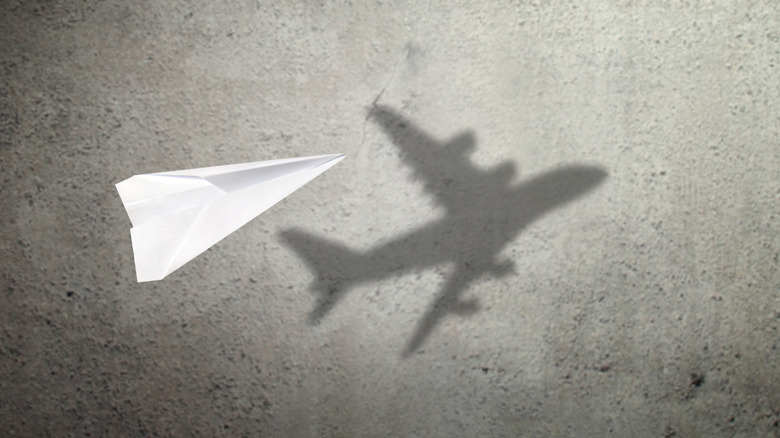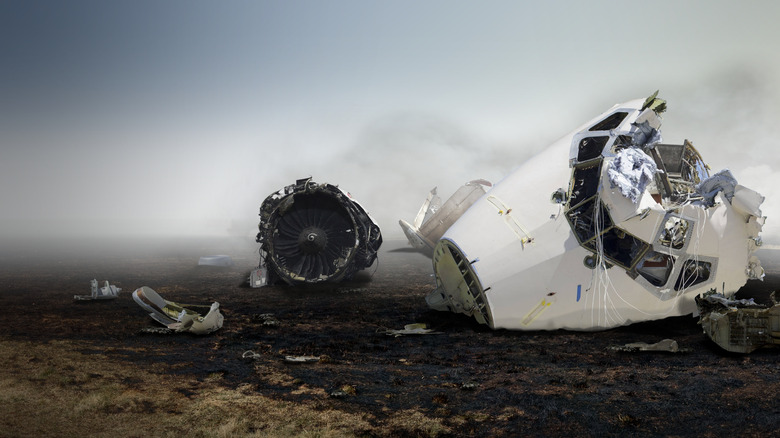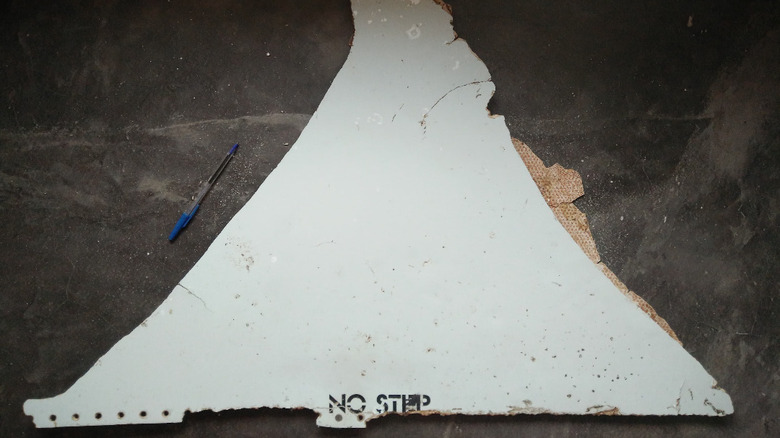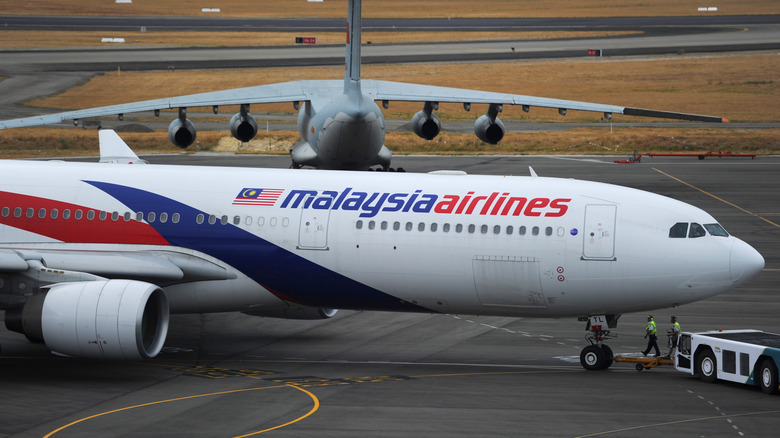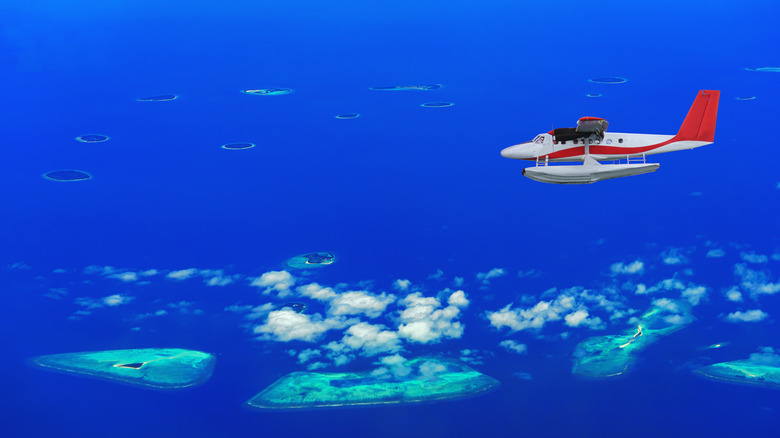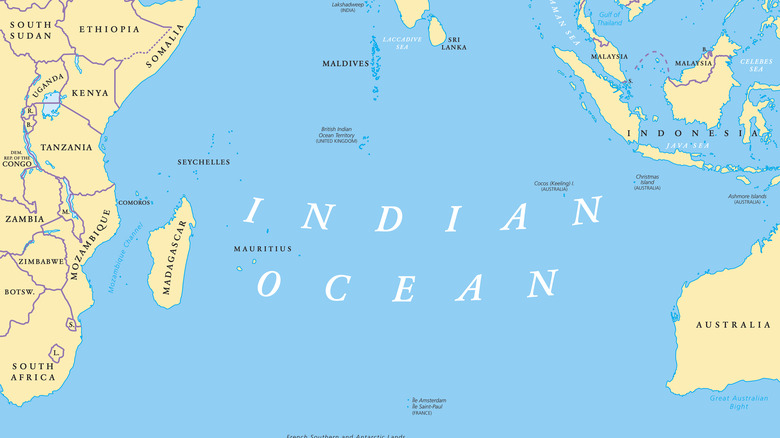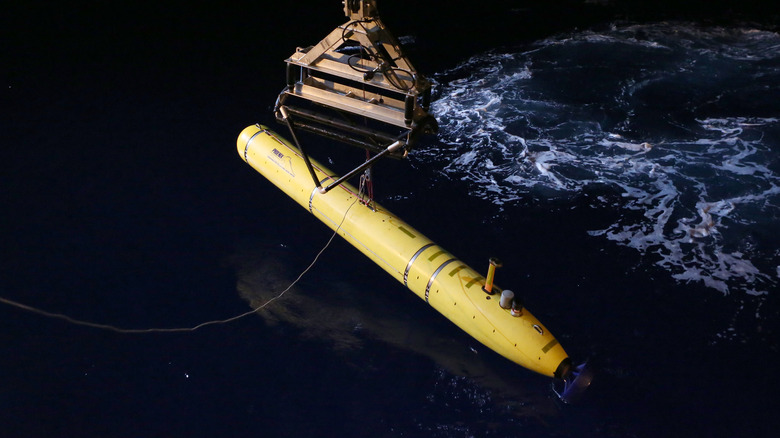Malaysia Flight 370: Chilling Details About The Mysterious Disappearance
We'd almost expect ships at sea to vanish considering how often it's happened in our collective human past, but a commercial airplane mysteriously vanishing while full of passengers seems like a bit of a stretch. When one just up and disappears one day, seemingly into the blue, it's even more far-fetched. A small private plane owned by the Russian mafia? Sure. A fighter jet in WWII? Most definitely. But a Boeing 777 fitted with all the high-end tracking and navigation technology the 21st century has to offer, with a cabin full of passengers? Seems a little sketchy. And, as far as we know, the disappearance of Flight 370 actually was pretty sketchy, to say the least.
Malaysia Airlines Flight 370 was carrying 239 people when it seemingly disappeared in March of 2014, taking the passengers with it. The flight left Kuala Lumpur, the capital of Malaysia, and was supposed to land in Beijing. Within an hour, the plane lost contact without so much as a quick message about what was happening on board — not even a distress signal. The disappearance is considered one of the biggest aviation mysteries to happen this millennium. How could one missing plane be so mysterious? That's the question that's been boggling investigators and one for which we might never have an answer. Here are some of the chilling details we do know about its mysterious disappearance.
Was the crash an act of terrorism?
In 2020, Malaysian leadership thought the incident to be a murder-suicide, but it was unclear who perpetrated it. If it was a terrorist hijacking, you'd think an organization would come forward and claim it; otherwise, there's really no point.
An attack by malicious hackers has been another theory proposed that also falls short of credibility. According to Jeff Wise's book, "The Plane That Wasn't There," the only option for hackers would be to take control of the plane through its satellite link, set the autopilot on to take it off course, and somehow keep the pilots from resuming control. Without that, there wasn't much of a possibility to exploit the flight system. Plus, that satellite link went down before the plane disappeared. So basically, that lead investigators to conclude that the person or people responsible for Flight 370's disappearance had to be on the plane at the time it went down.
The black box would definitely help
It might not be completely clear what happened to Malaysia Airlines Flight 370 until the plane's black box is recovered. Black boxes, also known as flight recorders, are governmentally-mandated devices installed on all planes to track and analyze flight data in case of tragedies like MH370. The evidence held within that particular recording device could be invaluable to understanding what occurred. If it's ever located, the wreckage of the flight itself might conceivably point investigators in the right direction. But that's part of the problem: Investigators can't even seem to find the plane.
And regardless, it was discovered a year after the flight's disappearance that the black box on Flight 370 had expired more than a year prior. The battery wasn't charged, meaning the black box onboard Malaysia Airlines Flight 370 may have struggled to relay or preserve the flight data to the central control center on land even if it was found.
Horrifying possibilities for the lack of debris
One major reason that the disappearance of Malaysia Flight 370 has generated so much mystery is that very little debris has been found. A year after the incident in 2015, mathematician Goong Chen ran data through computer simulations to figure out why. His results concluded that a vertical crash would have caused the plane to sink rapidly to the bottom of the ocean floor, leaving the plane largely intact and making it difficult to recover from the depths of the oceans to which it plunged (per CNN).
Over the years, almost two dozen fragments believed to be part of the plane have made it to the coasts of Madagascar. By far, the most significant piece recovered has been the trunnion door of the landing gear found in 2022. Damage to both the interior and exterior of the find indicates the grim reality that the equipment was extended before impact, which would only increase devastation.
The find indicates a grim reality that whoever was flying the aircraft crashed it on purpose. In their report, "Debris Analysis — Main Landing Gear Trunnion Door Panel," Blaine Gibson and Richard Godfrey came to the horrific conclusion that whoever was flying the plane crashed it on purpose. They explained, "The combination of the high speed impact designed to break up the aircraft and the extended landing gear designed to sink the aircraft as fast as possible both show a clear intent to hide the evidence of the crash."
The disappearance was an international tragedy
MH370 may have been a Malaysian Airlines flight leaving the country's capital city, Kuala Lumpur, and heading to Beijing, but most of the people on board were not Malaysian. Instead, the 227 passengers who mysteriously perished were from 14 different countries, leaving grieving family members across the globe with lots of unanswered questions about their missing loved ones, according to The Atlantic. Most depressing of all is the fact that five of the individuals on the flight were children.
Outside of the crew, there were only 38 Malaysians on board. Even fewer of the passengers were from the countries of Indonesia, Australia, India, France, the U.S., Iran, Ukraine, Canada, New Zealand, the Netherlands, Russia, and Taiwan. On the other hand, the rest, and the vast majority, were from China and presumably on their way home. Following the disaster, teams of law enforcement officials from both Malaysia and China carried out investigations of every single passenger with assistance from the FBI. All were cleared of suspicion, which means that if something nefarious occurred, none outside of the crew were involved and each one was an innocent victim.
Troubling details about one of the 12 crew members
Of the two pilots on Malaysia Flight 370, the first was 27-year-old Fariq Hamid. The trip to Beijing was his last training flight before earning his certification. The remainder of the crew consisted of 10 flight attendants and senior captain, Zaharie Ahmad Shah, who was one of the most experienced pilots in the country.
Among the crew, the one who had some very worrisome aspects about his background was Captain Zaharie. The 53-year-old lived alone since his kids had grown up to move out and his wife had left with little chance that she would return. A close friend told The Atlantic, "Zaharie's marriage was bad. In the past he slept with some of the flight attendants. And so what? We all do. You're flying all over the world with these beautiful girls in the back. But his wife knew."
Because of this, more than one friend described Zaharie as being sad quite often, bordering on depression. Though far more disturbing were the results uncovered from forensic examinations of a flight simulator the pilot frequently used in his periods of isolation. In particular, there was a path he played through which had a trajectory that was eerily similar to that of MH370 before it vanished — as if he was practicing for the tragic flight. While no solid evidence has even been discovered that proves Zaharie was responsible, the same friend who knew about his marital issues does not rule out the possibility.
Did the captain create a hypoxia event to kill the passengers?
After electrical engineer Mike Exner thoroughly examined the radar data from Malaysia Flight 370, he came to an absolutely chilling conclusion that at the time seemed to have solved at least part of the mysterious flight MH370 disappearance. At 40,000 feet, the emergency oxygen masks in the cabin no longer function and the plane flew at that height for more than enough time for depressurization to take full effect, causing the lethal condition called hypoxia to occur for everyone outside of the cockpit.
Federal Aviation Administration (FAA) guidelines require any flights above 10,000 feet to be pressurized. Otherwise, with what happens to your body on an airplane, passengers can be at risk of not getting enough oxygen to their blood, tissues, and cells for their bodies to function. The resulting hypoxia then creeps up unnoticed, causing passengers to first lose consciousness within a matter of minutes and then die in their sleep not long after. If Captain Zaharie Ahmad Shah, or whoever was piloting the aircraft, purposefully flew at such a high altitude, it could have been done as the simplest — although definitely brutal — way to prevent the passengers from ever interfering.
The unlikely theory that fruit and lithium batteries caused a fire
In the desperate struggle to find answers for the vanishing of MH370, a bizarre and terrifying, yet logical theory arose that a fire may have ignited in the cargo bay, leading to disaster. To spark the flames, the likely culprit was thought to be a container of lithium-ion batteries. This caused Boeing, the FAA, and most pilots to advocate for changes in how potentially dangerous goods would be stored in the future. Others voiced concern that a container held mangosteens that were out of season and contributed to the growing flames.
However, in 2018, an investigation was carried out by an international team from seven countries who examined the evidence and conducted comprehensive tests. In their "Safety Investigation Report," the investigators determined that not only was all of the cargo packaged safely but also that mangosteens and lithium batteries are flown so frequently without incident that the items were unlikely responsible. Tests also confirmed that even if the two items came into contact, the short duration of the flight made it nearly impossible for such a volatile reaction to occur.
Some have claimed to have seen the plane the day it disappeared
On the tragic day that Malaysia Flight 370 vanished, several people across a vast area stretching from Southeast Asia to the Maldives claimed to have seen the aircraft, and none of the accounts sounded like the flight was going according to plan. Most described an aircraft flying extremely low, while Mike McKay, a worker on an offshore oil rig near Vietnam, told CNN that he observed an object in the sky that was on fire. In Indonesia, the state news agency, Antara, reported that there were sightings of a crash from local fishermen.
In 2022, after systems engineer Sergio Cavaiuolo used Inmarsat satellite data and flight path tracks to figure out the trajectory of the plane, he realized that his conclusion was backed up by accounts from several people in the Maldives (via The Independent). Putting the data and the sightings together, Cavaiuolo is certain that the aircraft collided with the ocean surface in the Veymandoo Channel of the South-Central Atolls and the heartbreaking underwater grave of the 239 people on board is located there at the bottom of the sea.
People in China immediately boycotted travel to Malaysia
Not long after MH370 went missing, a huge number of Chinese citizens were either furious with Malaysia or afraid to travel there out of fear there would be another fatal incident. Around two-thirds of the 227 passengers on the flight scheduled for Beijing were from China, which left many family members in the country unsatisfied with the lack of information about the fate of their loved ones. Two weeks after the plane disappeared in March 2014, fiery protestors formed outside the Malaysian embassy in Beijing demanding answers, including about 200 relatives of the passengers.
The anger spread far beyond the capital as well, with a significant drop in Chinese tourism to Malaysia. The boycotts were fueled greatly by famous movie stars like Chen Kun and their millions of followers. On the social media site, Weibo, he stated (via the South China Morning Post), "I ... will start a boycott from my inner heart on any commercials and travel relating to Malaysia. This will last ... until the Malaysian government takes down their clown-like mask and tells the truth."
The most expensive search operation was a failure
The fact that very little of the wreckage from MH370 has been recovered is even more disturbing because of the massive amount of time, money, and resources spent in the initial search operation. An international effort put together $150 million to fund crews from Malaysia, Australia, and China to scan the sea floor of one of the largest bodies of water in the world, the Indian Ocean.
In the end, the teams were able to cover a vast amount of territory that added up to 46,000 square miles located 1,100 miles west of Australia, as reported by The Washington Post. By 2017, officials had realized that they were likely searching 200 miles too far south, but the governments supporting the operation decided that too much money had already been spent, so it was put to an end without finding any substantial evidence.
The troubling disappearance of MH370 led to new technology
As is too often the case, the Malaysia Flight 370 tragedy changed aviation, forcing the aviation industry to adopt new measures that could have prevented the disaster in the first place. Possibly the most critical change instituted by the International Civil Aviation Organization of the United Nations was to create a technology that could track flights globally from orbit, no matter how remote the location.
When talking with CNN, CEO Don Thoma of Aireon, the company that owns the technology, said, "This will be the first time ever that all aircraft are being tracked around the world in real time." To pull this incredible feat off, the company only needs to use 66 satellites to cover the entire planet. Before, there was a frightening amount of territory that aircraft could get lost in, not just over oceans, but also equally isolated regions like deserts, mountains, and dense forests. Now, the interconnected devices in orbit make it far more difficult to lose track of a plane.
Governments have not renewed search even with updated data
When the international mission to recover Malaysia Flight 370 ended in 2017, it was done so with the understanding that new evidence would restart the search. However, Peter Foley, the program director of the initial operation, believes that time has already arrived due to new data and technology. When talking to The Guardian, he stressed, "We should be searching, and this time we need to search until we find it." Despite his statements, the Australian government had taken no further actions as of early 2023.
With governmental authorities failing to act, specialists at Ocean Infinity hope to find the wreckage using a considerably cheaper budget than the initial search operation at $30 million. Yet they too face issues without the approval of the Malaysians who still own the aircraft. In an interview with 60 Minutes, Foley showed his full support for the private effort and said, "The more pressure that's applied to the Malaysian government by families, the more likely they are to say yes. They need to get behind Ocean Infinity on this." To this day, both Foley and Ocean Infinity remain committed to continuing the search, but governmental support is still absent.

